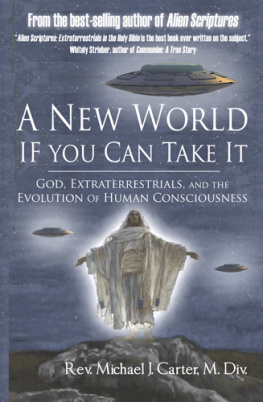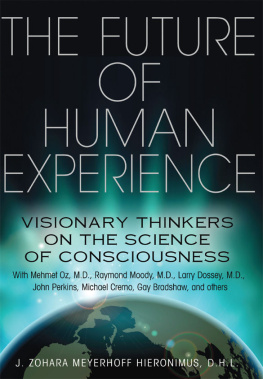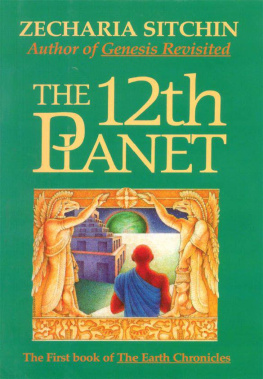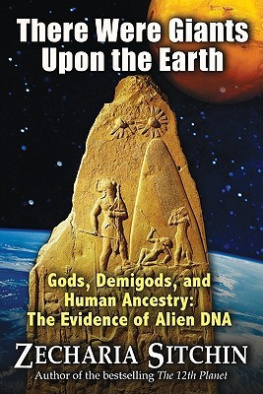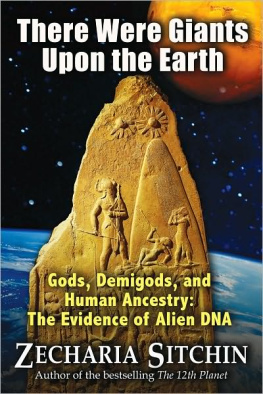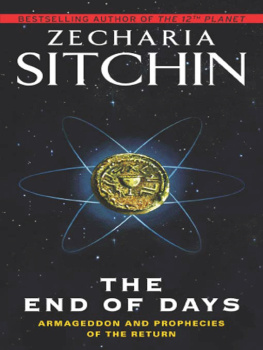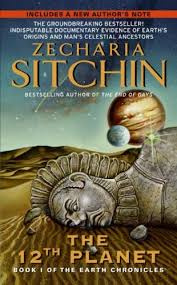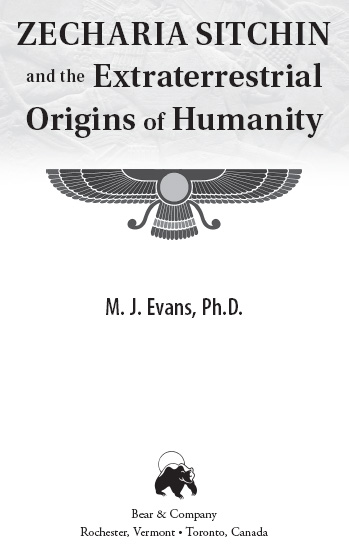
This book is dedicated to
Aaron, whose loving support
encouraged its writing,
and who helped me
to live again,
and to
Zecharia Sitchin,
whose energetic
scholarship serves as a
beacon for all those
who search for
enlightenment.
Acknowledgments
T his book draws on my professional and personal contact with Zecharia Sitchin and his works over nearly twenty years. It was mostly written during 20132014 from my desk in Alanya, Turkey, where the view of the majestic Taurus Mountains from my balcony provided valuable spiritual energy that energized my thoughts.
I elected to live in Turkey, a beautiful mountainous country, to continue to explore the many ancient sites that dot that countrys landscapes. I was reminded that there I shared the same landmass that was walked on by the Nefilim, Anunnaki, and Sumerians, the ancient ones who were the focus of Sitchins several books. The friend who reminded me of this geographic connection deserves recognition for his insight (thanks, Jim). While I know with certainty that the ancient spirits were available to help me shape this manuscript, I have no doubt that Zecharias spirit also helped me pull his most interesting contributions together and stimulated my thoughts about how to unpack them.
Many of my Sitchin friends, those who also knew him as teacher and friend, encouraged this book. Special mention goes to Joyce Thielen, John Cogswell, Lena Jacobson, Suzi and Dennis Strauch, Wally Motloch, Jennifer Stein, Barry Baumgarten, and Nora Gottlieb. To the spirit of Fritz Meyer (who passed as the final chapter was underway), I send prayers for a safe journey as he joins Zecharia up there. He was one of the first Sitchin fans and along with his wife, Judy, was supportive of my work.
I am particularly indebted to my Turkish colleague, Suat Dokumaci, who helped me through frustrating computer glitches and answered my questions about ancient sites, Islam, and Turkish culture. His familyMine, Rana, Azra, and Asyatook great care to provide me with a sense of family and home life during my long stay in their country.
My family in Syracuse, New York, North and South Carolina, and other farflung places across the United States provided me with the support and encouragement I needed to engage fully in my writing and travel adventures.
This work owes a debt of gratitude to the staff at Inner Traditions without whose encouragement, support, and technical assistance the book would have never seen the light of day. Special thanks go to Jeanie Levitan, editor in chief; Jennie Marx, project editor; Nancy Yeilding, copy editor; and Jon Graham, acquisitions editor.
Prologue
Zecharia SitchinAuthor, Ancient Historian, and Explorer of Archaeology
If a man does not keep pace with his companions,
perhaps it is because he hears a different drummer.
Let him step to the music which he hears,
however measured or far away.
HENRY DAVID THOREAU, WALDEN
Z echaria Sitchin was a dedicated researcher who undertook to unravel every unanswered challenge embedded in the materials he studied. He followed his intellectual curiosity and used it to work outside the box (if necessary) to pursue clues he discovered. His tendency for independent thinking surfaced when he was a child, when he made an astute observation that he believed to be a translation error in the biblical Book of Genesis. The word Nefilim had been translated as giants, but he believed that translation was incorrect. When he tried to get his teachers assistance to confirm the accuracy of his observation, he was told not to question The Bible. Thereafter, unable to abandon his belief that the word, when accurately translated, actually means those who came down, he launched a quest to find evidence answering this question: Who came down? His search for the answer took him from childhood across a long journey of study and research.

Fig. P.1. Zecharia Sitchin on a tour in Mexico. (Photograph by Wally Motloch)
Previous scholars were unable to fully interpret and accurately decipher whatin Sitchins judgmentwas the actual story of the ancient space travelers as told on the Sumerian clay tablets. The scholars who first worked on the tablets did their writing at the end of the nineteenth century and in the first decade of the twentieth century. The space age did not develop for several decades after those pioneers did their work. As a result, these early researchers and scholars had no context within which to understand the space age material they were reading, and their first published works showed that they thought the tablets were mythology. Sitchin, on the other hand, was conversant with modern space age technology and recognized it in the ancient records.
Because Sitchin taught himself to read Sumerian and the languages that derived from itnamely Akkadian, Babylonian, and ancient Hebrewhe had the linguistic skills that allowed him to recognize the truth embedded in the information he read. He fervently believed the tablet records were not telling of mythical beliefs of the ancient people. As new space age events emerged in modern times, he mastered cosmology, celestial mechanics, and even genetic science, which provided the explanations that matched the true meanings. In essence, with the modern science, he found the key to fully understand the actual meaning embedded in the ancient clay tablets.
Through his penetrating analysis, Sitchin discovered that these stories were reports of what actually happened when an ancient civilization came to Earth using their highly advanced capability for interplanetary travel. The information Sitchin uncovered from his own reading and translation of the cuneiform script told a fascinating story. These first settlers came in space vehicles to obtain gold needed on their planet; they used advanced space technology to transship the gold they found here back to their home planet. This is the essence of the content that Sitchin found in the tablet materials and he brought it to light for modern societys edification as his scholarly and personal contribution.
***
It must have been a twist of fate that prompted me to attend a conference with the unusual title, When Cosmic Cultures Meet, an event organized by the Human Potential Foundation. On May 26, 1995 I arrived at the conference venue, the Washington Sheraton Hotel, with only the expectation of exercising my academic curiosity by listening to informative presentations by notable researchers like John Mack, M.D., Ruth Montgomery, Richard Boyland, Ph.D., R. Leo Sprinkle, Ph.D., Charles Tart, Ph.D., and J. J. Hurtak, Ph.D., and the well-known futurist, John Peterson, to name just a few of the several presenters. My expectation was that these experts would enlarge my understanding of phenomena that represented intrusions by other galactic cultures into Earths realm and illuminate intercultural contact between them and us.
My curiosity about this topic was informed by my reading about the 1947 unidentified flying object (UFO) that crashed in Arizona. In the first few days the original information about this UFO crash that left debris scattered across a large crash site made the published news media. But within a few days, following the takeover of the site and its debris by the U.S. military, the original report was contradicted. What was fascinating in the original news report was that beings were found on board the vehicle. The mystery about what happened to the beings and the debris continued to deepen as time passed. Was there cultural contact? That question haunts the interested public as there still are few clear answers. The original report implied the real possibility of alien contact with Earths inhabitants, so I wanted to know more about what current researchers had to say about this possibility.


